- BY kq
- POSTED IN Indian Marble
- WITH 0 COMMENTS
- PERMALINK
- STANDARD POST TYPE
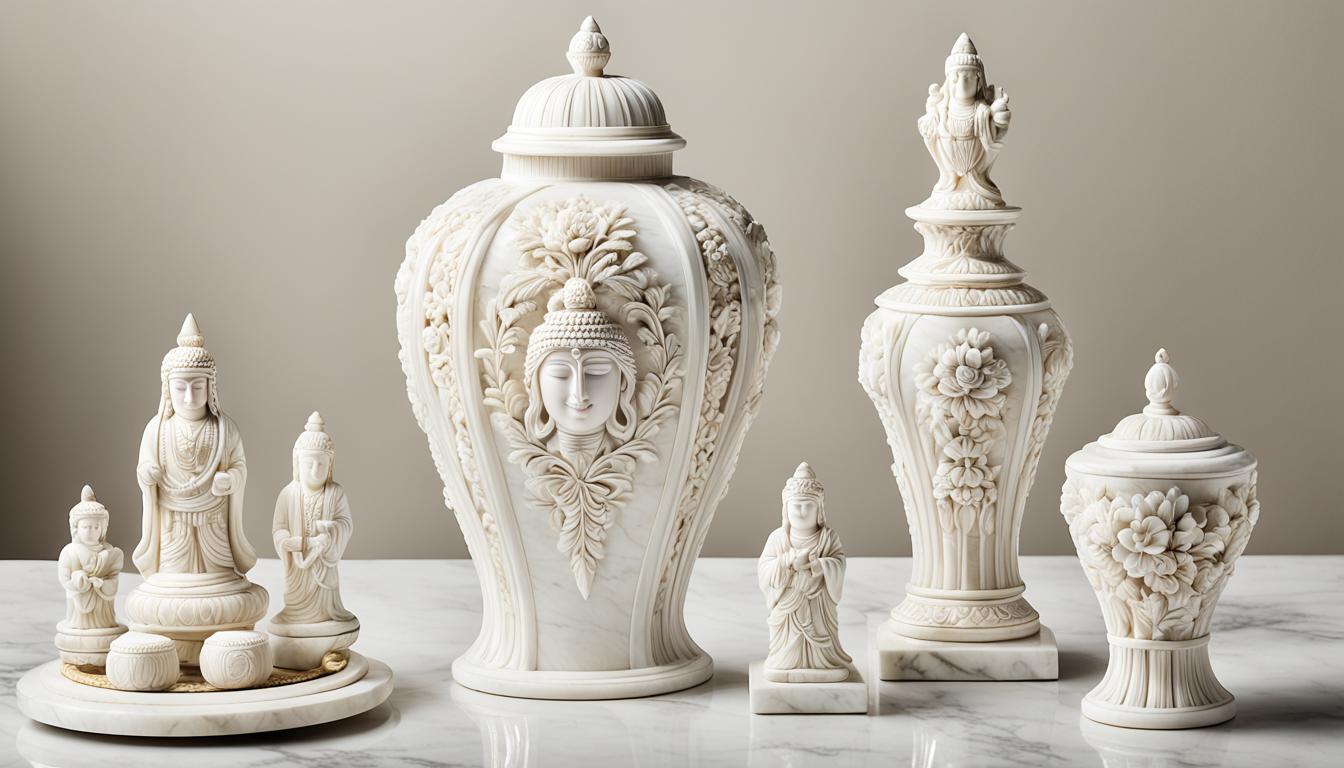
Indian marble artifacts value. India’s museums are a treasure trove of invaluable marble artifacts that offer a captivating glimpse into the country’s rich cultural heritage. These marble masterpieces, ranging from iconic sculptures to ancient coins, hold immense historical and artistic significance. Understanding the true value of these marble pieces is crucial for preserving and appreciating India’s remarkable marble legacy. This article will delve into the fascinating world of indian marble artifacts, exploring their historical importance, the factors that influence their antique marble pieces india, and the challenges in conserving this cultural heritage.
Key Takeaways
- India’s museums house a vast collection of priceless indian marble artifacts that offer insights into the country’s cultural history.
- Understanding the value of these marble treasures is crucial for preserving and appreciating India’s remarkable marble legacy.
- indian marble sculpture pricing is influenced by factors such as rarity, historical significance, and artistic merit.
- Experts play a vital role in marble artifact appraisal india to authenticate and determine the value of these cultural assets.
- Conserving and protecting India’s marble heritage face various challenges, necessitating collective efforts to safeguard these invaluable artifacts.
Introduction to Indian Marble Artifacts: Indian Marble Artifacts Value
India’s rich cultural heritage is intricately woven into the intricate and captivating world of marble artifacts. This versatile material, prized for its timeless beauty and enduring durability. Has a cherished medium for artists and craftsmen throughout the country’s illustrious history.
Historical Significance of Marble Art in India
The use of marble in Indian art and architecture can be traced back to ancient civilizations. With the Maurya, Gupta, and Mughal empires leaving an indelible mark on this enduring tradition. Iconic structures like the Taj Mahal, Agra Fort, and Hawa Mahal stand as testament to the historical significance of marble. Showcasing its seamless integration into the country’s architectural masterpieces.
Variety of Marble Artifacts Found in India
- Exquisite marble sculptures, ranging from the graceful “Dancing Girl” of the Harappan era to the captivating “Siva Nataraja” at the National Museum in Delhi
- Intricate marble carvings, including delicate filigree work and intricate bas-relief designs
- Decorative marble art pieces, such as vases, lamps, and boxes, reflecting the skilled craftsmanship of Indian artisans
- Marble artifacts used in religious and ceremonial contexts, including statues of deities and temple accoutrements
- Marble coins and other numismatic treasures, providing insights into ancient Indian currencies and trade
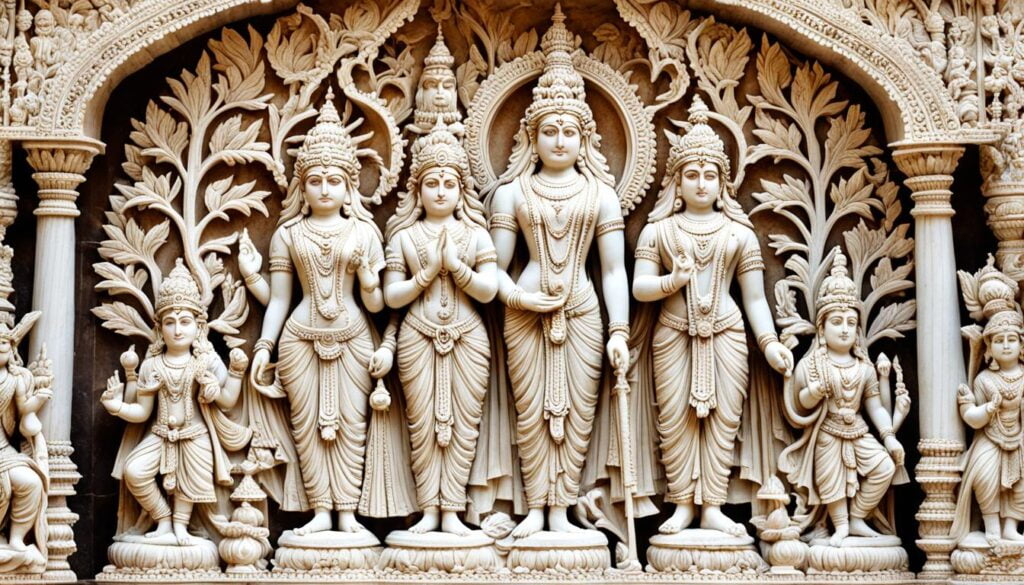
Today, museums and collections across India proudly showcase the diverse array of marble artifacts that have stood the test of time. Bearing witness to the country’s rich artistic heritage and the enduring allure of this timeless medium.
Iconic Marble Sculptures in Indian Museums : Indian Marble Artifacts Value
Indian museums are home to some of the most captivating and historically significant marble sculptures in the world. The National Museum in Delhi, for instance, houses two renowned masterpieces. That offer a glimpse into the country’s rich artistic heritage: the ‘Siva Nataraja’ and ‘The Dancing Girl’ from the Harappan civilization.
Lord of Dance ‘Siva Nataraja’ at National Museum, Delhi
The ‘Siva Nataraja’ is a stunning bronze sculpture that depicts the Hindu deity Shiva in his cosmic dance. Showcasing the remarkable artistry and technical skill of the Medieval era. This iconic work of art, which stands at the National Museum in Delhi. Captures the energy and dynamism of Shiva’s dance. Symbolizing the continuous cycle of creation, preservation, and destruction that is central to Hindu philosophy.
‘The Dancing Girl’ from Harappan Civilization at National Museum, Delhi
Another remarkable artifact housed at the National Museum is ‘The Dancing Girl’. A small yet remarkably detailed bronze figurine that offers a glimpse into the artistic. And metallurgical prowess of the Harappan civilization, dating back to 2500 BCE. This captivating sculpture, which measures just over 10 centimeters in height. A testament to the advanced techniques and aesthetic sensibilities of the Indus Valley people. Who were among the earliest urban cultures in the world.
These marble and bronze sculptures are just a few of the many treasures that Indian museums have preserved. Providing invaluable insights into the country’s rich cultural and artistic heritage. With over seven hundred museums currently operating in India. The nation’s collections of indian marble sculpture pricing, marble artifact appraisal india. And indian carved marble valuation offer a unique window into the evolution of Indian art and civilization.
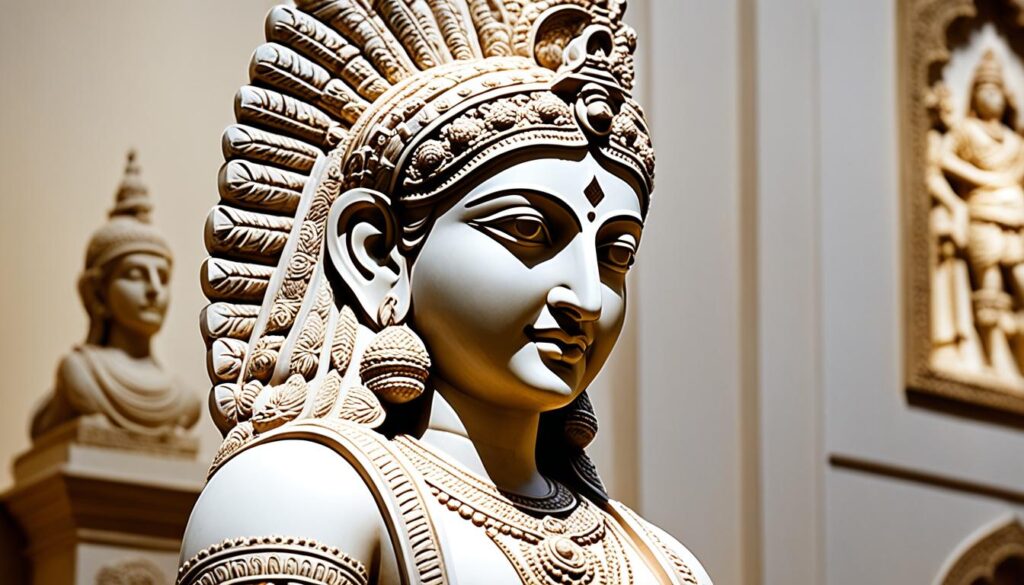
“The sculptures in the Indian subcontinent primarily consist of stone, metal, or terracotta due to the challenging climate for the long-term survival of organic materials.”
Coin Collections: A Glimpse into Ancient Indian Currencies
Beyond the captivating marble sculptures. Indian museums house extensive collections of ancient coins that offer a unique window into the country’s rich monetary history. The Indian Museum in Kolkata, for instance, boasts a remarkable collection of over 52,000 coins. Spanning from the 4th-5th century BCE to the present day. These coins, many of which are original artifacts, provide invaluable insights into the diverse currencies. That circulated across the Indian subcontinent throughout the centuries.
The museum’s coin gallery displays some of the earliest indigenous uninscribed coins. As well as a diverse range of coins that reflect the evolving political and economic landscape of ancient India. From the Indo-Greek coins that blended Hellenistic and Indian artistic elements to the coins issued by Islamic dynasties like the Delhi Sultanate and the Mughals. Which showcased a fusion of Islamic calligraphy. Persian influences, and Indian artistry, these collections offer a captivating glimpse into India’s monetary heritage.
For researchers, historians, and collectors seeking to understand the rich numismatic legacy of India. These coin collections are an indispensable resource. They shed light on the economic and cultural exchanges that took place across the region. As well as the technical and artistic advancements in coin minting over the centuries. The Indian marble artifacts value and marble antiquities India price guide can also better understood through the study of these ancient coins.
“These coin collections are an invaluable resource for researchers, historians, and collectors seeking to understand the rich monetary heritage of the country.”
From the earliest uninscribed coins to the modern-day cryptocurrencies that are reshaping global finance. The story of Indian currencies is a fascinating tapestry of cultural exchange. Technological innovation, and enduring artistic expression. The indian marble figurine value assessment can be further enriched by exploring the diverse coin collections housed in India’s museums.
indian marble artifacts value: Assessing the Worth
Determining the true value of Indian marble artifacts requires a deep understanding of the factors that influence their worth. The historical significance, artistic merit, condition, rarity. And provenance of a marble piece are just a few of the key considerations. That come into play when assessing its value. Additionally, the expertise and authentication provided by art appraisers. And conservators are crucial in establishing the authenticity and worth of these cultural treasures.
Factors Influencing the Value of Marble Artifacts
The value of Indian marble artifacts is determined by a combination of factors, including:
- Historical Significance: The deeper the historical connection of the artifact to India’s rich cultural heritage, the more it is likely to be valued by collectors and enthusiasts.
- Artistic Merit: The level of craftsmanship, intricate detailing, and artistic expression embodied in the marble piece can significantly impact its worth.
- Condition: The preservation and physical state of the artifact, from any cracks or chips to the overall patina, are crucial in determining its value.
- Rarity: The scarcity and uniqueness of the marble artifact, especially if it is a one-of-a-kind piece or part of a limited production, can drive up its market value.
- Provenance: The documented history and ownership trail of the artifact can lend credibility and increase its perceived worth among collectors.
Expert Appraisal and Authentication
Varun Marbles, a leading marble artifact dealer in India, has extensive experience in evaluating the value of these prized possessions. Drawing upon their deep knowledge of the market and the unique characteristics of each piece. By understanding the various factors that contribute to the value of Indian marble artifacts. Collectors and enthusiasts can make informed decisions when acquiring or investing in these remarkable cultural icons.
“The expertise and authentication provided by art appraisers and conservators are crucial in establishing the authenticity and worth of these cultural treasures.”
According to industry experts, the Indian marble market is expected to witness robust growth in the coming years. Driven by factors such as the government’s focus on infrastructure development. And the increasing demand for high-quality natural stones. With the right expertise and a keen eye for detail. Investors and collectors can uncover the hidden value of these timeless Indian marble artifacts. Preserving and appreciating the country’s rich cultural legacy.
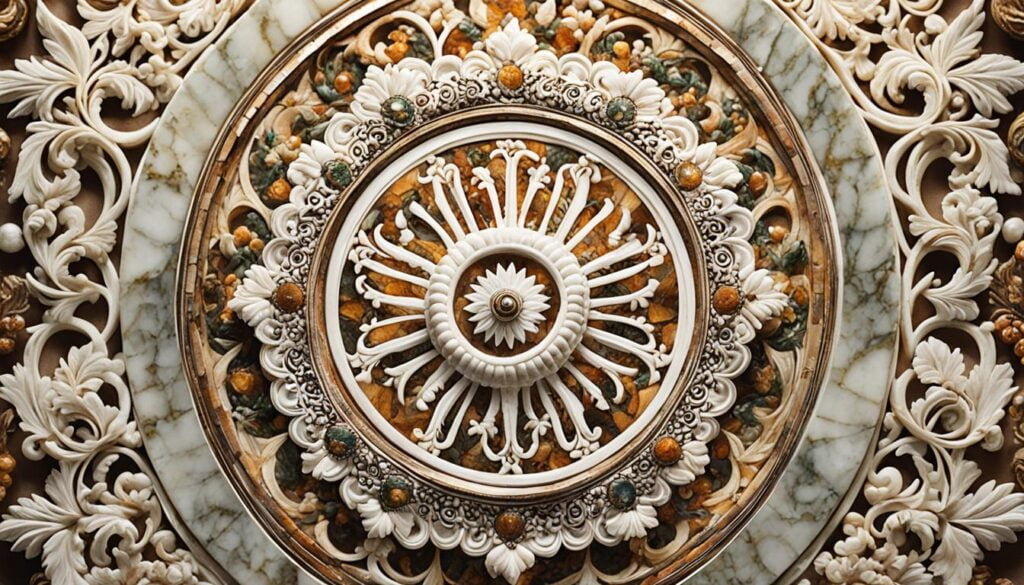
Preserving India’s Marble Heritage
India’s diverse and captivating collection of marble artifacts is a testament to the country’s rich cultural heritage. However, the preservation of these invaluable treasures poses significant challenges. That museums and cultural organizations must grapple with. Marble, while a durable material, is susceptible to environmental factors such as humidity, temperature fluctuations. And air pollution, all of which can lead to gradual deterioration over time.
Adding to the complexity of marble artifact conservation are the logistical challenges of transporting and storing these delicate pieces. Specialized techniques and expertise are required to ensure the long-term protection and safekeeping of India’s marble legacy. Organizations like Varun Marbles have been at the forefront of advocating for more robust preservation efforts. Working closely with museums and cultural authorities to develop strategies that ensure the continued protection and conservation of these invaluable marble treasures.
Challenges in Marble Artifact Conservation : Indian Marble Artifacts Value
Preserving India’s marble handicrafts and marble antiquities poses several unique challenges:
- Environmental factors: Humidity, temperature fluctuations, and air pollution can cause significant damage to marble artifacts over time.
- Fragility and transportation: Delicate marble pieces require specialized handling and transportation methods to prevent breakage or deterioration.
- Specialized conservation techniques: Effective preservation of indian marble artifacts necessitates the expertise of trained conservators and the use of specialized techniques.
- Lack of resources: Limited funding and infrastructure can hinder the comprehensive preservation of India’s vast marble heritage.
By addressing these challenges and implementing comprehensive conservation strategies. India can ensure that its remarkable marble legacy is safeguarded for generations to come. Preserving the intrinsic value and cultural significance of these marble antiquities.
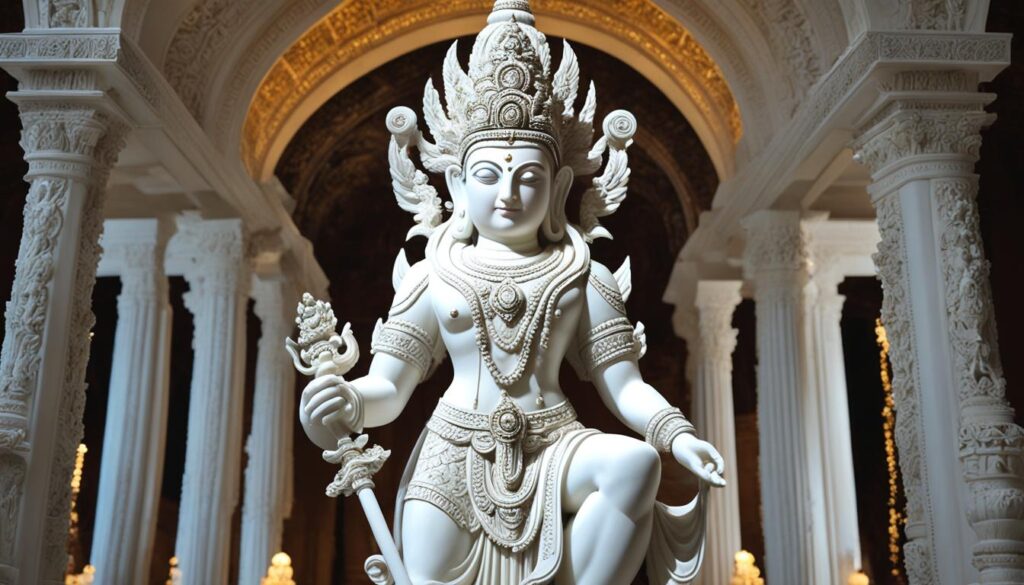
Collectors’ Insights: Acquiring and Appreciating Marble Artifacts
For art collectors and enthusiasts, the acquisition and appreciation of Indian marble artifacts is a deeply rewarding pursuit. These cultural treasures not only hold immense historical and artistic value. But they also offer a tangible connection to the rich heritage of the country. Varun Marbles, a trusted name in the Indian marble artifact market, has worked extensively with collectors. Providing them with expert guidance and insight into the nuances of acquiring and caring for these remarkable pieces.
From understanding the unique characteristics of different marble types to navigating the complexities of provenance and authentication. Varun Marbles has helped collectors build exceptional collections that celebrate the enduring legacy of India’s marble artistry. By fostering a deeper appreciation for these cultural icons. Collectors play a vital role in preserving and promoting India’s marble heritage on the global stage.
The Allure of Marble Artifacts
The captivating appeal of Indian marble artifacts lies in their timeless beauty and profound cultural significance. These exquisite creations, meticulously carved by skilled artisans, have the power to transport observers to bygone eras, evoking a sense of wonder and reverence. Collectors are drawn to the intricate details, the raw elegance, and the stories that each piece holds, making the acquisition of these treasures a deeply personal and fulfilling experience.
Navigating the Market with Expertise
Navigating the market for Indian marble artifacts can be a complex endeavor, fraught with challenges of authenticity, provenance, and valuation. Varun Marbles’ team of experts guides collectors through this intricate landscape, ensuring that their acquisitions are not only aesthetically captivating but also possess genuine historical and cultural significance.
Through their extensive knowledge of the market, Varun Marbles provides invaluable insights into factors influencing the value of marble artifacts, from the rarity of the piece to the craftsmanship and age of the work. This expertise enables collectors to make informed decisions, build cohesive collections, and unlock the true potential of these remarkable cultural assets.
Preserving India’s Marble Heritage
By acquiring and appreciating Indian marble artifacts, collectors play a vital role in preserving the country’s rich cultural legacy. These pieces serve as tangible reminders of India’s artistic heritage, inspiring awe and admiration in both domestic and international audiences.
Varun Marbles, with its deep-rooted commitment to responsible sourcing and conservation, works closely with collectors to ensure the proper care and maintenance of these fragile treasures. Through this collaborative effort, the intrinsic value and significance of India’s marble heritage are safeguarded for generations to come.
| Collector | Prized Marble Acquisitions | Market Value |
|---|---|---|
| Kiran Nadar | SH Raza’s Saurashtra, Bharti Kher’s The Skin Speaks a Language of its Own | Rs 16.5 crore, Rs 6.5 crore |
| Tina Ambani | F.N. Souza’s The Birth | Rs 10.5 crore |
| Parmeshwar Godrej | Jehangir Sabavala, Krishen Khanna, Arpana Caur, Anjolie Ela Menon, Manu Parekh | N/A |
| Malvinder Singh | Arpita Singh’s Wish Dream, Atul Dodiya’s Three Painters | Rs 9.6 crore |
| Harsh Goenka | M.F. Husain, Souza, Padamsee | N/A |
The table showcases the prized marble acquisitions and their market values for renowned Indian art collectors, highlighting the significant value and prestige associated with these cultural artifacts.
“Acquiring and preserving Indian marble artifacts is not just a pastime, but a means of safeguarding our cultural legacy for future generations. Each piece we collect is a testament to the enduring artistry and craftsmanship of our ancestors.”
– Varun Marbles, leading expert in the Indian marble artifacts market
Legendary Marble Masterpieces Lost to Time : Indian Marble Artifacts Value
Throughout history, numerous priceless marble treasures have been lost or stolen, depriving the world of their cultural and artistic significance. The Amber Room, a stunning 18th-century chamber adorned with amber panels and gold-gilded carvings, was dismantled by the German forces during World War II and has not been seen since. Similarly, the sarcophagus of the Egyptian pharaoh Menkaure, discovered in the 1830s, was lost when the ship transporting it sank during its journey to England. These tragic tales serve as a sobering reminder of the fragility of our cultural heritage and the importance of safeguarding these irreplaceable indian marble artifacts value.
Tales of Missing and Stolen Marble Treasures
The loss of these marble antiquities india price guide is a devastating blow to the preservation of our shared history. Varun Marbles, in its efforts to promote the preservation of India’s marble legacy, has been at the forefront of advocating for stricter measures to protect these precious indian marble figurine value assessment from the threat of theft, loss, and destruction.
One of the most renowned missing marble masterpieces is the Colossal Statue of Augustus, a remarkable sculpture of the first Roman Emperor that stood over 12 meters in height. This ancient marvel, crafted in the early 1st century CE, vanished without a trace, leaving a void in our understanding of classical Roman art.
The Amber Room, a stunning 18th-century chamber adorned with amber panels and gold-gilded carvings, was dismantled by the German forces during World War II and has not been seen since.
Similarly, the Statue of Hercules, a masterpiece reassembled from 112 pieces, showcasing the hero of Greek mythology, has been lost to the ravages of time. These tales of missing and stolen indian marble artifacts value serve as a poignant reminder of the fragility of our cultural heritage and the ongoing efforts to preserve and protect these irreplaceable treasures.
As Varun Marbles continues to champion the preservation of India’s marble legacy, the search for these lost masterpieces remains a priority. The value of these marble antiquities india price guide extends far beyond their monetary worth, as they represent the pinnacle of human creativity and the enduring power of artistic expression. The loss of these indian marble figurine value assessment is not just a cultural tragedy but a profound blow to our collective understanding of our shared history.
Emerging Trends in Marble Artifact Collection
The appreciation and collection of indian marble artifacts value have witnessed a growing trend in recent years, driven by a renewed interest in the country’s rich cultural heritage and the increasing value placed on these timeless treasures. Collectors, both within India and around the world, are seeking out rare and remarkable marble pieces, fueling a vibrant market for these coveted marble handicrafts india worth.
Varun Marbles, a leading player in the Indian marble artifact trade, has observed a surge in demand for these cultural icons, as discerning collectors recognize their immense historical significance and artistic merit. This evolving landscape has also led to the emergence of specialized appraisal and authentication services, ensuring the provenance and indian marble figurine value assessment of these marble treasures are properly established.
Indian marble artifacts
As the fascination with Indian marble artifacts continues to grow, Varun Marbles remains at the forefront of this trend, connecting collectors with the most extraordinary and valuable pieces that celebrate the enduring legacy of India’s marble heritage.
- Approx. ₹13,000 per piece for Marble Minakari Table Clock.
- Approx. ₹10,000 per piece for Marble Garden Artifacts, Black Marble Coaster Set, Gold Foil Marble Tray Set, Marble Inlay Flower Vase, Marble Carving Artifacts, Marble Artifacts, Marble Pot, and Marble Flower Pot.
- 83% Response Rate for retailer from Chennai.
- Manufacturer established in the year 2003.
The average price of a 8-10ft White Marble Temple is ₹4,500 per square foot. While a Raj Creations Marble Ganesh Article priced at ₹800 per piece with an 85% response rate. A Marble Chopping Board sells for ₹750 per piece with an 84% response rate, and Brown Marble Fruit Planters priced at ₹10,000 per piece.
As the fascination with indian marble artifacts value continues to grow, Varun Marbles remains at the forefront of this trend, connecting collectors with the most extraordinary and valuable pieces that celebrate the enduring legacy of India’s marble heritage.
Conclusion
Indian marble artifacts hold immense cultural, historical, and artistic value, offering a window into the country’s rich heritage and the remarkable skill of its artisans. From iconic sculptures to ancient coin collections, these marble treasures showcase the diverse and enduring legacy of India’s marble craftsmanship. Understanding the true indian marble artifacts value is crucial for preserving and celebrating this remarkable cultural legacy.
Organizations like Varun Marbles played a vital role in promoting the appreciation and conservation of antique marble pieces india, working with collectors, museums. And cultural authorities to ensure these priceless treasures safeguarded for generations to come. As the fascination with Indian marble art continues to grow. The need to protect and celebrate this heritage never more important. Ensuring that the hidden marble artifact appraisal india fully realized and honored.
The diverse and exceptional range of Indian marble, from the Royal White Makrana to the vibrant Indian Green Marble, adds a touch of elegance and sophistication to high-end interior design, both within India and globally. This versatile and durable material has found applications in flooring, cladding, and artistic installations, cementing its status as a symbol of luxury and timeless craftsmanship.
FAQ
What is the historical significance of marble art in India?
India has a long and storied history of marble craftsmanship, with the use of this versatile material dating back to ancient civilizations. Marble has been a medium of choice for artists and sculptors, who have used it to create breathtaking works of art that have stood the test of time, from the intricate carvings of the Maurya Dynasty to the elegant sculptures of the Mughal era.
What types of marble artifacts found in Indian museums?
Indian museums are home to a diverse array of marble artifacts, including iconic sculptures, ancient coins, and exquisite decorative pieces that reflect the country’s rich artistic heritage.
Can you tell me more about the famous marble sculptures in Indian museums?
The National Museum in Delhi houses two renowned masterpieces: the ‘Siva Nataraja’ and ‘The Dancing Girl’ from the Harappan civilization. The ‘Siva Nataraja’ is a stunning bronze sculpture that depicts the Hindu deity Shiva in his cosmic dance, showcasing the remarkable artistry and technical skill of the Medieval era. The ‘Dancing Girl’ a small yet remarkably detailed bronze figurine that offers a glimpse into the artistic. And metallurgical prowess of the Harappan civilization, dating back to 2500 BCE.
What can the ancient coin collections in Indian museums tell us?
The Indian Museum in Kolkata boasts a collection of over 52,000 coins, spanning from the 4th-5th century BCE to the present day. These coins, many of which are originals, provide valuable insights into the various currencies that were in circulation across the Indian subcontinent throughout the centuries, offering a unique perspective on the country’s monetary history.
What factors influence the value of Indian marble artifacts?
The historical significance, artistic merit, condition, rarity, and provenance of a marble piece are just a few of the key considerations that come into play when assessing its value. Additionally, the expertise and authentication provided by art appraisers and conservators are crucial in establishing the authenticity and worth of these cultural treasures.
What are the challenges in preserving India’s marble heritage?
Marble, while a durable material, is susceptible to environmental factors such as humidity, temperature fluctuations, and air pollution, all of which can lead to significant deterioration over time. Additionally, the logistical challenges of transporting and storing these delicate artifacts, as well as the need for specialized conservation techniques, add to the complexity of preserving India’s marble heritage.
How can collectors acquire and appreciate Indian marble artifacts?
Collectors, both within India and around the world, are seeking out rare and remarkable marble pieces, fueling a vibrant market for these coveted artifacts. Organizations like Varun Marbles have played a vital role in connecting collectors with the most extraordinary and valuable pieces, providing expert guidance and insight into the nuances of acquiring and caring for these remarkable cultural treasures.
What some examples of legendary marble masterpieces that lost over time?
The Amber Room, a stunning 18th-century chamber adorned with amber panels. And gold-gilded carvings, was dismantled by the German forces during World War II and not seen since. Similarly, the sarcophagus of the Egyptian pharaoh Menkaure, discovered in the 1830s. Was lost when the ship transporting it sank during its journey to England.
What the emerging trends in the collection of Indian marble artifacts?
The appreciation and collection of Indian marble artifacts have witnessed a growing trend in recent years, driven a renewed interest in the country’s rich cultural heritage and the increasing value placed on these timeless treasures. This evolving landscape also led to the emergence of specialized appraisal and authentication services, ensuring the provenance and value of these marble treasures properly established.


Recent Comments